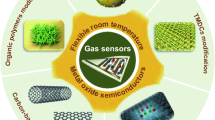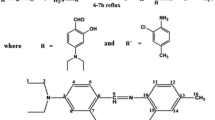Abstract
Two kinds of WO3 powders with average size of 100 nm and 5 μm have been used to prepare Pt–WO3 porous composite ceramics, whose WO3 grains are around 1 and 5 μm, respectively. The ceramics with 1 μm WO3 grains show a sensitivity of 755 to 0.08% H2 – 20% O2 – N2 in air of 30% relative humidity (RH) at room temperature, but show no response to this concentration of hydrogen in air of 50% RH due to the depression effect of water, which indicate a relatively low humidity tolerance for the ceramics. In contrast, the ceramics with 5 μm WO3 grains show sensitivities of 1200 and 80 to 0.08% H2 – 20% O2 – N2 at room temperature in air of 30% and 50% RH, respectively, and a sensitivity of 8 to 0.02% H2 – 20% O2 – N2 in air of 70% RH, which represent an ultrahigh humidity tolerance. These results clearly demonstrate that the microstructure of room-temperature hydrogen sensitive metal oxide (MOX) materials exerts a decisive influence on their humidity tolerance. Much attention should be paid to MOX materials with large and even ultra-large MOX grains when room-temperature MOX gas sensors with high humidity tolerance are being developed.






Similar content being viewed by others

References
S.D. Bakrania, M.S. Wooldridge, The effects of two thick film deposition methods on tin dioxide gas sensor performance. Sensors 9, 6853–6868 (2009)
G. Korotcenkov, Handbook of gas sensor materials: properties, advantages and shortcomings for applications (Springer Press, New York, 2013)
L. Boon-Brett, J. Bousek, G. Black et al., Identifying performance gaps in hydrogen safety sensor technology for automotive and stationary applications. Int. J. Hydrogen Energy 35, 373–384 (2010)
M.E. Franke, T.J. Koplin, U. Simon, Metal and metal oxide nanoparticles in chemiresistors: does the nanoscale matter? Small 2, 36–50 (2006)
R. Vander Wal, G. Hunter, J. Xu et al., Metal-oxide nanostructure and gas-sensing performance. Sens. Actuators B 138, 113–119 (2009)
G. Jimenez-Cadena, J. Riu, F.X. Rius, Gas sensors based on nanostructured materials. Analyst 132, 1083–1099 (2007)
X.R. Xu, M. Yin, N. Li et al., Vanadium-doped tin oxide porous nanofibers: enhanced responsivity for hydrogen detection. Talanta 167, 638–644 (2017)
Y.K. Kim, S.-H. Hwang, S.M. Jeong et al., Colorimetric hydrogen gas sensor based on PdO/metal oxides hybrid nanoparticles. Talanta 188, 356–364 (2018)
Y. Xiong, W.P. Chen, Y.S. Li et al., Contrasting room-temperature hydrogen sensing capabilities of Pt-SnO2 and Pt-TiO2 composite nanoceramics. Nano Res. 9, 3528–3535 (2016)
S. Zhu, P.C. Li, G.T. Wu et al., Extraordinary room-temperature hydrogen sensing capabilities with high humidity tolerance of Pt-SnO2 composite nanoceramics prepared using SnO2 agglomerate powder. Int. J. Hydrogen Energy 43, 21177–21185 (2018)
C.B. Song, G.T. Wu, B.L. Sun et al., Pt-WO3 porous composite ceramics outstanding for sensing low concentrations of hydrogen in air at room temperature. Int. J. Hydrogen Energy 42, 6420–6424 (2017)
W.P. Chen, Y. Xiong, Y.S. Li et al., Extraordinary room-temperature hydrogen sensing capabilities of porous bulk Pt–TiO2 nanocomposite ceramics. Int. J. Hydrogen Energy 41, 3307–3312 (2016)
P.C. Li, Z.H. Xiong, S. Zhu et al., Singular room-temperature hydrogen sensing characteristics with ultrafast recovery of Pt-Nb2O5 porous composite ceramics. Int. J. Hydrogen Energy 42, 30186–30192 (2017)
B. Pejcic, P. Eadington, A. Ross, Environmental monitoring of hydrocarbons: a chemical sensor perspective. Environ. Sci. Technol. 41, 6333–6342 (2007)
G. Korotcenkov, Practical aspects in design of one-electrode semiconductor gas sensors: status report. Sens. Actuators B 121, 664–678 (2007)
K.-I. Choi, M. Huebner, A. Haensch et al., Ambivalent effect of Ni loading on gas sensing performance in SnO2 based gas sensor. Sens. Actuators B 183, 401–410 (2013)
F.E. Annanouch, Z. Haddi, S. Vallejos et al., Aerosol-assisted CVD-grown WO3 nanoneedles decorated with copper oxide nanoparticles for the selective and humidity-resilient detection of H2S. ACS Appl. Mater. Interf. 7, 6842–6851 (2015)
G. Korotcenkov, I. Blinov, V. Brinzari et al., Effect of air humidity on gas response of SnO2 thin film ozone sensors. Sens. Actuators B 122, 519–526 (2007)
K. Suematsu, N. Ma, M. Yuasa et al., Surface-modification of SnO2 nanoparticles by incorporation of Al for the detection of combustible gases in a humid atmosphere. RSC Adv. 5, 86347–86354 (2015)
S. Gunji, M. Jukei, Y. Shimotsuma et al., Unexpected gas sensing properties of SiO2/SnO2 core-shell nanofibers under dry and humid conditions. J. Mater. Chem. C 5, 6369–6376 (2017)
H.R. Kim, A. Haensch, I.D. Kim et al., The role of NiO doping in reducing the impact of humidity on the performance of SnO2-based gas sensors: synthesis strategies, and phenomenological and spectroscopic studies. Adv. Funct. Mater. 21, 4456–4463 (2011)
D. Koziej, N. Baˆrsan, U. Weimar et al., Water-oxygen interplay on tin dioxide surface: implication on gas sensing. Chem. Phys. Lett. 410, 321–323 (2005)
A.M. Ruiz, X. Illa, R. Díaz et al., Analyses of the ammonia response of integrated gas sensors working in pulsed mode. Sens. Actuators B 118, 318–322 (2006)
S. Vallejos, S. Selina, F.E. Annanouch et al., Aerosol assisted chemical vapour deposition of gas sensitive SnO2 and Au-functionalised SnO2 nanorods via a non-catalysed vapour solid (VS) mechanism. Sci. Rep. 6, 28464 (2016)
G. Heiland, D. Kohl, Physical and chemical aspects of oxidic semiconductor gas sensors. Chem Sensor Technol 1, 15–38 (1988)
D. Patil, Y.-K. Seo, Y.K. Hwang et al., Humidity sensing properties of poly(o-anisidine)/WO3 composites. Sens. Actuators B 128, 374–382 (2008)
N. Yamazoe, K. Suematsu, K. Shimanoe, Two types of moisture effects on the receptor function of neat tin oxide gas sensor to oxygen. Sens. Actuators B 176, 443–452 (2013)
S. Harbeck, A. Szatvanyi, N. Barsan et al., DRIFT studies of thick film un-doped and Pd-doped SnO2 sensors: temperature changes effect and CO detection mechanism in the presence of water vapour. Thin Solid Films 436, 76–83 (2003)
R.G. Pavelko, H. Daly, C. Hardacre et al., Interaction of water, hydrogen and their mixtures with SnO2 based materials: the role of surface hydroxyl groups in detection mechanisms. Phys. Chem. Chem. Phys. 12, 2639–2647 (2010)
S. Zhu, Y. Liu, G.T. Wu et al., Mechanism study on extraordinary room-temperature CO sensing capabilities of Pd-SnO2 composite nanoceramics. Sens. Actuators B 285, 49–55 (2019)
J.-H. Smått, M. Lindén, T. Wagner et al., Micrometer-sized nanoporous tin dioxide spheres for gas sensing. Sens. Actuators B 155, 483–488 (2011)
J. Zhang, X.H. Liu, G. Neri et al., Nanostructured materials for room-temperature gas sensors. Adv. Mater. 28, 795–831 (2016)
Acknowledgements
This work was funded by the National Natural Science Foundation of China under Grant No. U2067207, the Science and Technology Program of Shenzhen under Grant No. JCYJ20190808152803567, and the National Key R&D Program of China under Grant No. 2020YFB2008800.
Author information
Authors and Affiliations
Corresponding author
Ethics declarations
Conflict of interest
The authors declared that they have no conflicts of interest to this work.
Additional information
Publisher's Note
Springer Nature remains neutral with regard to jurisdictional claims in published maps and institutional affiliations.
Rights and permissions
About this article
Cite this article
Huang, Y., Li, P., Xu, L. et al. Ultrahigh humidity tolerance of room-temperature hydrogen sensitive Pt–WO3 porous composite ceramics with ultra-large WO3 grains. Appl. Phys. A 127, 952 (2021). https://doi.org/10.1007/s00339-021-05107-2
Received:
Accepted:
Published:
DOI: https://doi.org/10.1007/s00339-021-05107-2



